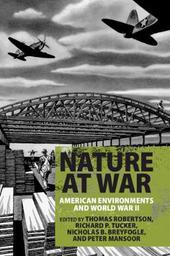
|
Nature at War: American Environments and World War II
Paperback / softback
Main Details
| Title |
Nature at War: American Environments and World War II
|
| Authors and Contributors |
Edited by Thomas Robertson
|
|
Edited by Richard P. Tucker
|
|
Edited by Nicholas B. Breyfogle
|
|
Edited by Peter Mansoor
|
| Physical Properties |
| Format:Paperback / softback | | Pages:387 | | Dimensions(mm): Height 227,Width 153 |
|
| Category/Genre | Second world war
History of science |
|---|
| ISBN/Barcode |
9781108412070
|
| Classifications | Dewey:940.5310973 |
|---|
| Audience | | Professional & Vocational | | Tertiary Education (US: College) | |
|---|
| Illustrations |
Worked examples or Exercises; 10 Tables, black and white; 6 Maps; 20 Halftones, black and white; 4 Line drawings, black and white
|
|
Publishing Details |
| Publisher |
Cambridge University Press
|
| Imprint |
Cambridge University Press
|
| Publication Date |
2 April 2020 |
| Publication Country |
United Kingdom
|
Description
This anthology is the first sustained examination of American involvement in World War II through an environmental lens. World War II was a total and global war that involved the extraction, processing, and use of vast quantities of natural resources. The wartime military-industrial complex, the 'Arsenal of Democracy,' experienced tremendous economic growth and technological development, employing resources at a higher intensity than ever before. The war years witnessed transformations in American agriculture; the proliferation of militarized landscapes; the popularization of chemical and pharmaceutical products; a rapid increase in energy consumption and the development of nuclear energy; a remaking of the nation's transportation networks; a shift in population toward the Sunbelt and the West Coast; a vast expansion in the federal government, in conjunction with industrial firms; and the emergence of environmentalism. World War II represented a quantitative and qualitative leap in resource use, with lasting implications for American government, science, society, health, and ecology.
Author Biography
Thomas Robertson is Executive Director of the United States Educational Foundation (USEF) Fulbright in Kathmandu, Nepal and the author of The Malthusian Moment: Global Population Growth and the Birth of American Environmentalism (2012). Richard P. Tucker is Adjunct Professor in the School for Environment and Sustainability at the University of Michigan. He is co-editor of four multi-author books on the environmental history of the two World Wars. His previous publications include Insatiable Appetite: The United States and the Ecological Degradation of the Tropical World (2000). Nicholas B. Breyfogle is Associate Professor of History at The Ohio State University. He is the author/editor of seven volumes, including Water History: Readings and Sources (2020) and Eurasian Environments: Nature and Ecology in Imperial Russian and Soviet History (2018). Peter Mansoor is the General Raymond E. Mason Jr. Chair of Military History at The Ohio State University. He is the author of three books and co-editor of three volumes, including the award-winning The GI Offensive in Europe: The Triumph of American Infantry Divisions, 1941-1945 (1999).
Reviews'Featuring renowned scholars of military and environmental history, Nature at War shows how the mid-century clash between Allied and Axis forces revolutionized every aspect of American life - from the food we eat, to the smoke we breath, to the clothes we wear and the chemicals and drugs that pour through our veins. This impressive volume is long overdue and should be essential reading for anyone interested in the ecological history of the world's 'darkest hour'.' Bart Elmore, The Ohio State University 'Nature at War reveals how World War II was literally a War on the World. While claiming 60 million lives and devastating land, air, and water, WWII also transformed the US by promoting industrial agriculture, chemical pesticides, out-of-control military spending, rampant consumerism, nicotine addiction, and urban smog. A remarkable accounting.' Gar Smith, co-founder of Environmentalists Against War and author of Nuclear Roulette and The War and Environment Reader 'The necessity and even glory of World War II is unquestionable in US culture, and even in this book. Yet this book makes clear that the world could never survive another similar disaster, not only because of the nuclear danger, but also because of the environmental destruction created and unleashed by that war. In fact, the earth-attacking practices of extraction and consumption that grew out of WWII may yet doom us all if not undone and corrected.' David Swanson, author of War Is A Lie 'Nature at War offers the first book length analysis of the environmental developments during World War II in the United States, and raises questions of thunderous importance for the rest of the world as well.' Simo Laakkonen, University of Turku
|